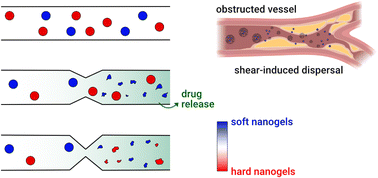Tailored mechanosensitive nanogels release drugs upon exposure to different levels of stenosis†
Abstract
Owing to the unhealthy lifestyle and genetic susceptibility of today's population, atherosclerosis is one of the global leading causes of life-threatening cardiovascular diseases. Although a rapid intervention is required for severe blood vessel constrictions, a systemic administration of anticoagulant drugs is not the preferred method of choice as the associated risk of bleeding complications is high. In this study, we present mechanosensitive nanogels that exhibit tunable degrees of disintegration upon exposure to different levels of stenosis. Those nanogels can be further functionalized to encapsulate charged drug molecules such as heparin, and they efficiently release their cargo when passing stenotic constrictions; however, passive drug leakage in the absence of mechanical shear stress is very low. Furthermore, heparin molecules liberated from those mechanosensitive nanogels show a similar blood clot lysis efficiency as the free drug molecules, which demonstrates that drug encapsulation into those nanogels does not interfere with the functionality of the cargo. Thus, the hemocompatible and mechanoresponsive nanogels developed here represent a smart and efficient drug delivery platform that can offer safer solutions for vascular therapy.



 Please wait while we load your content...
Please wait while we load your content...